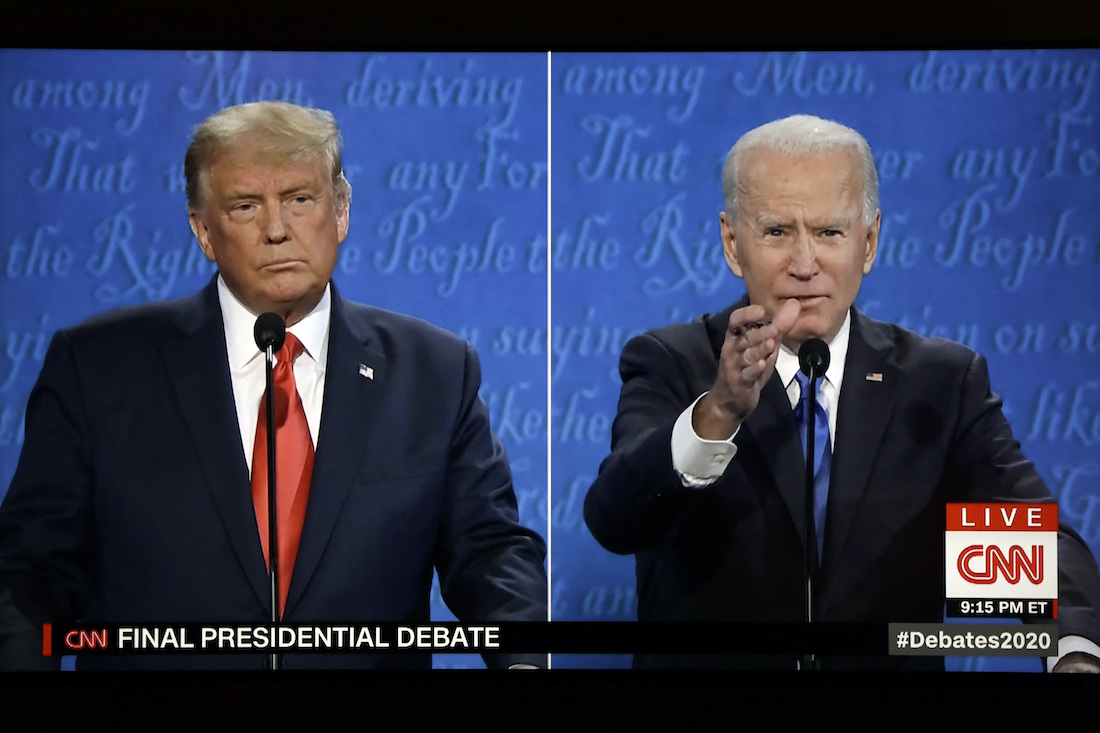President Donald Trump and former Vice President Joe Biden faced off for their second and last debate of the 2020 campaign season on Thursday night at Belmont University in Nashville. The candidates offered viewers a far more staid and substantive exchange than their first debate – a low bar, to be sure. Despite the improved tone, did all of their factual assertions hold up? Here are the facts.
Did no one lose coverage under Obamacare? And will BidenCare’s public option destroy private health insurance?
Biden: Public option is an option that says that if you, in fact, do not have the wherewithal to be – if you qualify for Medicaid, and you do not have the wherewithal in your state to get Medicaid, you automatically are enrolled, providing competition for insurance companies. … Not one single person, private insurance, would lose their [health] insurance under my plan, nor did they under Obamacare. They did not lose their insurance unless they chose, they wanted to go to something else.
Perhaps the most egregious fib of the night belonged to Joe Biden, who said that “not one single person” lost his or her health insurance plan under the Affordable Care Act, conventionally known as Obamacare. In reality, 5.9 million people lost their health insurance according to a study from the RAND Corporation. This author involuntarily lost his health insurance plan, specifically because it did not fit the guidelines of the ACA. While a Goldman Sachs study found that more Americans had coverage after the ACA, it did not compare the quality of their plans before and after President Obama’s signature healthcare reform. Further, as many as 63% of new enrollees ended up swelling state Medicaid rolls, and two-thirds of Medicaid expansion enrollees were already eligible.
This is not controversial or new. Politifact chose President Obama’s claim that “if you like your health care plan, you can keep it” as 2013’s lie of the year; The Washington Post’s fact-checker, Glenn Kessler gave it four Pinocchios; and NBC News reported in that President Obama had known his statement was erroneous “for at least three years.”
The claim “was not true under Obamacare. And it will not be true under Biden’s plan, either,” writes healthcare expert Sally Pipes in her new article from the forthcoming Fall 2020 issue of Religion & Liberty. Pipes explains the exact mechanism that the public option, which is heavily supported by labor unions, will use to put private insurers out of business. Under Biden’s plan, the government would offer health insurance to “compete” with the private market. However, as Pipes outlines, the government healthcare plan can price itself below private insurance, because it can operate at a loss and force U.S. taxpayers to plug the hole. Health providers will then charge the privately insured more, raising the cost of private insurance premiums and driving more people onto the public option. Eventually, the government will establish a monopoly over the insurance industry through attrition.
Is New York losing population?
Trump: [T]ake a look at New York and what’s happened to my wonderful city. For so many years, I loved it. It was vibrant. It’s dying. Everyone’s leaving New York.
President Trump is right that New York has experienced tremendous population churn. Only Alaska saw more of its residents move to other states during the last decade. Approximately 1.4 million people left New York state from 2010-2019, according to the Empire Center – a fact Democratic Gov. Andrew Cuomo attributes to high taxes. “They’re not coming back right now, and you know what else they’re thinking? ‘If I stay there, I pay a lower income tax because they don’t pay the New York City surcharge,’” he said. The American Legislative Exchange Council’s annual “Rich States, Poor States” report named New York as the state with the worst economic outlook.
However, President Trump’s comments centered on New York City. The Big Apple has had little population change in decades, thanks to strict rent control policies producing an artificial housing shortage. And until recently, Brooklyn, Queens, the Bronx, and Manhattan experienced mild population gains. However, the COVID-19 pandemic and the city’s limp response to this summer’s riots – which drew Gov. Cuomo’s condemnation – drove hundreds of thousands of residents out of the city. “Overall since March, more than 246,000 people have filed a change of address request. That’s an almost 100% increase compared to the same time period in 2019,” according to ABC 7.
Did China pay billions in tariffs?
Trump: China is paying. They’re paying billions and billions of dollars. I just gave $28 billion to our farmers.
Biden: Taxpayers’ money.
Trump: It’s what?
Biden: Taxpayers’ money.
Trump: No, the taxpayers. It’s called China.
Trump: China pays for $28 billion and you know what they did to pay it, Joe? They devalued their currency and they also paid up, and you know who got the money? Our farmers. Our great farmers, because they would target it. … Also, I charged them 25% on dumped steel, because they were killing our steel industry. We were not going to have a steel, and now we have a steel industry
This exchange led Biden to use his trademark phrase, “malarkey.” He’s right: that’s not how tariffs work. The U.S. Customs and Border Patrol collects tariffs, not directly from the exporting country, but from U.S. importers. Ultimately, they pass their costs on to American consumers, who either pay for the tariffs by having them priced into the products they buy or by purchasing a more expensive alternative.
Donald Trump has waged a one-front trade war on China as part of his grand design to decouple the world’s two leading economies. In the short term, it has cost both economies. Moody’s Analytics assessed that “since it began in earnest … the trade war with China has cost an estimated 0.3 percentage point in U.S. real GDP and almost 300,000 jobs.” Even with taxpayer subsidies, Chapter 12 farm bankruptcies increased nearly 20% in 2019.
The Chinese economy has undeniably suffered, although the opaque nature of Beijing’s true economic figures makes it difficult to know how much. New tariffs reduced U.S. imports of Chinese goods by $35 billion, according to the United Nations, and overall Chinese exports contracted. Manufacturers also stepped up their preexisting plans to relocate their factories outside China. In this sense, China has paid for the tariffs, but the pain has been widely distributed.
Will a national $15 minimum wage cause businesses to close?
Biden: There is no evidence that when you raise the minimum wage, business has gone out of business. That is simply not true.
The “Fight for $15” has such strong support in the Democratic Party that, during the Democratic primaries, South Bend Mayor Pete Buttigieg said anyone who opposes a $15-an-hour minimum wage “taunts” God. Experts dispute the full job loss attributable to raising the minimum wage. A Congressional Budget Office’s analysis found that a $15 minimum wage would throw between 1.3 million and 3.7 million people out of work, costing the economy $9 billion total.
However, the problem with a high national minimum wage is not just job loss. After Seattle raised its citywide minimum wage to $15 an hour, workers experienced “a net loss of $125 per month (6.6 percent),” according to a report from the University of Washington – an amount its authors noted “is sizable for a low-wage worker.”
President Trump was right to say that in “some places, $15 is not so bad,” but it would decimate the economy of others. Canada’s Fraser Institute found that a minimum wage hurt low-wage workers the most and fell hardest on economically weak areas.
Will Joe Biden’s environmental policy cost $100 trillion?
Trump: [Economists] came out and said very strongly, “$6,500 will be taken away from families under his plan,” that his plan is an economic disaster. … They want to spend $100 trillion. That’s their real number. He’s trying to say it was six. It’s $100 trillion. …
Biden: I don’t know where he comes from. I don’t know where he comes up with these numbers. $100 trillion? Give me a break.
President Trump’s $100 trillion price tag refers to the estimated cost of the Green New Deal, proposed by Rep. Alexandria Ocasio-Cortez and her democratic socialist allies in “The Squad” (or, as Trump referred to them, “AOC plus three”). Biden has said he opposes the Green New Deal; however, his campaign website maintains that “Biden believes the Green New Deal is a crucial framework for meeting the climate challenges we face.” And as her Senate press releases note, vice presidential hopeful Kamala Harris “is a supporter and original co-sponsor of the original Green New Deal resolution.”
Brian Riedl of the Manhattan Institute did a back-of-the-envelope analysis of the GND’s cost on Twitter, setting the bill at roughly $100 million. However, he concluded the plan’s fantastical promises render it “basically incalculable.” While the American Action Forum agreed that “the breadth of its proposals makes it daunting to assess the GND,” a study co-authored by Douglas Holtz-Eakin placed its total cost at $93 trillion. That includes $36 trillion for universal national healthcare, something Biden has not officially endorsed. While $100 trillion potentially overstates the cost of the Green New Deal, it’s certain that the Squad will “push” Biden to expand the size, and cost, of his own plan.
Is renewable energy the fastest growing industry in America?
Biden: The fastest growing industry in America are – is, is, is the electric – excuse me, solar energy and wind.
The fastest-growing industry in the United States is forestry, according to the Bureau of Labor Statistics. That is followed by “individual and family services” and “support activities for mining.” Coal mining is also among the nation’s 20 most rapidly declining industries. For more on the effects of renewable energy, click here.
Bonus fact check: Joe Biden’s position on fracking
Biden: I have never said I oppose fracking.
Trump: You said it on tape.
Biden: I did? Show the tape.
I already fact-checked this claim during the vice presidential debate. You can see the verdict, and watch a video of Vice President Biden’s statements on the matter, here. Spoiler: Joe Biden has, at times, said that he opposes fracking, full-stop, as has his running mate, Sen. Kamala Harris. For more on her positions on the issues, click here.

